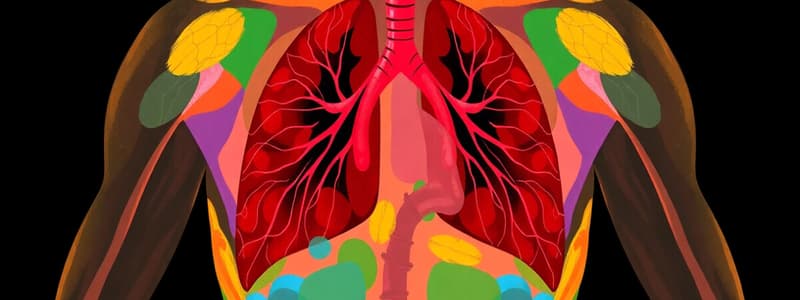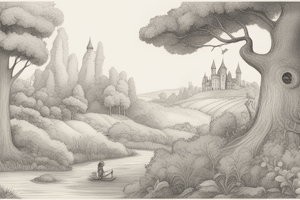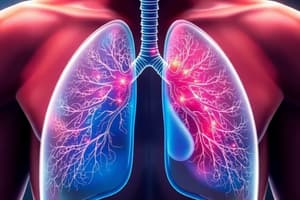Podcast
Questions and Answers
Which gas is present in greater concentration in inhaled air compared to exhaled air?
Which gas is present in greater concentration in inhaled air compared to exhaled air?
- Oxygen (correct)
- Carbon Dioxide
- Nitrogen
- Hydrogen
What is the role of the diaphragm during exhalation?
What is the role of the diaphragm during exhalation?
- It moves upwards, contributing to the decrease in lung volume. (correct)
- It remains static without any movement.
- It contracts forcefully to expel air quickly.
- It moves downward to increase lung volume.
What is the primary function of the larynx?
What is the primary function of the larynx?
- To facilitate gas exchange in the lungs
- To filter air before it reaches the lungs
- To produce sound through vocal cord vibrations (correct)
- To connect the bronchi to the trachea
What happens to the air pressure inside the lungs during inhalation?
What happens to the air pressure inside the lungs during inhalation?
Which of the following statements about limewater in the experiment is correct?
Which of the following statements about limewater in the experiment is correct?
Which statement accurately describes the alveoli?
Which statement accurately describes the alveoli?
What effect does the contraction of rib muscles have during inhalation?
What effect does the contraction of rib muscles have during inhalation?
What separates the thoracic cavity from the abdominal cavity?
What separates the thoracic cavity from the abdominal cavity?
How many alveoli are approximately present in the human lungs?
How many alveoli are approximately present in the human lungs?
What connects the nasal passages to the lungs?
What connects the nasal passages to the lungs?
What does pulling the rubber sheet down simulate in the breathing process?
What does pulling the rubber sheet down simulate in the breathing process?
Which material in the experiment represents the rib cage?
Which material in the experiment represents the rib cage?
What is the result when the rubber sheet is released after being pulled down?
What is the result when the rubber sheet is released after being pulled down?
During the measurement of chest cavity size, what change is expected when a person takes a deep breath?
During the measurement of chest cavity size, what change is expected when a person takes a deep breath?
What role do the deflated balloons play in the experiment?
What role do the deflated balloons play in the experiment?
Which statement accurately describes the primary function of the lungs?
Which statement accurately describes the primary function of the lungs?
What is the main difference between breathing and respiration?
What is the main difference between breathing and respiration?
Which muscles are primarily involved in the process of inhalation?
Which muscles are primarily involved in the process of inhalation?
During exhalation, which of the following occurs?
During exhalation, which of the following occurs?
What is the main role of breathing in relation to respiration?
What is the main role of breathing in relation to respiration?
What is the primary function of respiration?
What is the primary function of respiration?
Which part of the respiratory system serves as a common pathway for both food and air?
Which part of the respiratory system serves as a common pathway for both food and air?
What role do the nasal hairs play in the respiratory system?
What role do the nasal hairs play in the respiratory system?
What happens during sneezing?
What happens during sneezing?
Which of the following is NOT a common disease associated with the respiratory system?
Which of the following is NOT a common disease associated with the respiratory system?
What is the average breathing rate of a person in a resting state?
What is the average breathing rate of a person in a resting state?
How much does the breathing rate increase during fast running?
How much does the breathing rate increase during fast running?
After which activity would you expect the highest breathing rate?
After which activity would you expect the highest breathing rate?
What is the first step in the activity designed to find the breathing rate?
What is the first step in the activity designed to find the breathing rate?
What should be recorded in the table after conducting the breathing rate experiment?
What should be recorded in the table after conducting the breathing rate experiment?
What is the primary consequence of airway inflammation in asthma?
What is the primary consequence of airway inflammation in asthma?
During which respiratory process does oxygen combine with hemoglobin?
During which respiratory process does oxygen combine with hemoglobin?
What occurs during cellular respiration?
What occurs during cellular respiration?
What is primarily transported by the blood to body cells?
What is primarily transported by the blood to body cells?
What do body cells release back into the bloodstream during internal respiration?
What do body cells release back into the bloodstream during internal respiration?
Which symptom is commonly associated with tuberculosis?
Which symptom is commonly associated with tuberculosis?
What is a primary cause of pneumonia?
What is a primary cause of pneumonia?
What type of inflammation is characteristic of bronchitis?
What type of inflammation is characteristic of bronchitis?
Which of the following is NOT a treatment for tuberculosis?
Which of the following is NOT a treatment for tuberculosis?
Which symptom could signify the presence of asthma?
Which symptom could signify the presence of asthma?
Which demographic is particularly vulnerable to pneumonia?
Which demographic is particularly vulnerable to pneumonia?
What diagnostic method is commonly used for both tuberculosis and pneumonia?
What diagnostic method is commonly used for both tuberculosis and pneumonia?
Which of the following is a typical symptom of bronchitis?
Which of the following is a typical symptom of bronchitis?
What is the primary function of cellular respiration?
What is the primary function of cellular respiration?
Which structures are specifically responsible for gas exchange in the lungs?
Which structures are specifically responsible for gas exchange in the lungs?
What is the process of inhalation characterized by?
What is the process of inhalation characterized by?
How can tuberculosis be effectively prevented in children?
How can tuberculosis be effectively prevented in children?
What characterizes external respiration?
What characterizes external respiration?
Which of the following statements is true regarding pneumonia?
Which of the following statements is true regarding pneumonia?
Which system is primarily responsible for the mechanical process of breathing?
Which system is primarily responsible for the mechanical process of breathing?
What occurs during exhalation?
What occurs during exhalation?
Flashcards
Exhaled air vs. Inhaled air
Exhaled air vs. Inhaled air
Exhaled air has less oxygen and more carbon dioxide than inhaled air.
Inhalation
Inhalation
The process of taking air into the lungs.
Exhalation
Exhalation
The process of breathing air out of the lungs.
Carbon Dioxide in Exhaled Air
Carbon Dioxide in Exhaled Air
Signup and view all the flashcards
Thoracic Cavity Expansion
Thoracic Cavity Expansion
Signup and view all the flashcards
Breathing definition
Breathing definition
Signup and view all the flashcards
Respiration (biochemical)
Respiration (biochemical)
Signup and view all the flashcards
Breathing mechanism
Breathing mechanism
Signup and view all the flashcards
What does the rubber sheet represent?
What does the rubber sheet represent?
Signup and view all the flashcards
What happens to the balloons when the rubber sheet is pulled down?
What happens to the balloons when the rubber sheet is pulled down?
Signup and view all the flashcards
What happens to the balloons when the rubber sheet is released?
What happens to the balloons when the rubber sheet is released?
Signup and view all the flashcards
What is the effect when the rubber sheet is pulled down?
What is the effect when the rubber sheet is pulled down?
Signup and view all the flashcards
How does chest cavity size change during breathing?
How does chest cavity size change during breathing?
Signup and view all the flashcards
What is the larynx?
What is the larynx?
Signup and view all the flashcards
Trachea's role
Trachea's role
Signup and view all the flashcards
Lung function
Lung function
Signup and view all the flashcards
Alveoli
Alveoli
Signup and view all the flashcards
What does the diaphragm do?
What does the diaphragm do?
Signup and view all the flashcards
What does respiration involve?
What does respiration involve?
Signup and view all the flashcards
What does the respiratory system do?
What does the respiratory system do?
Signup and view all the flashcards
What does breathing through the nose do?
What does breathing through the nose do?
Signup and view all the flashcards
Why do we sneeze?
Why do we sneeze?
Signup and view all the flashcards
What are some common respiratory diseases?
What are some common respiratory diseases?
Signup and view all the flashcards
Breathing Rate
Breathing Rate
Signup and view all the flashcards
Breathing Rate During Exercise
Breathing Rate During Exercise
Signup and view all the flashcards
Why does breathing rate increase?
Why does breathing rate increase?
Signup and view all the flashcards
Breathing Rate After Rest
Breathing Rate After Rest
Signup and view all the flashcards
Breathing Rate Under Different Conditions
Breathing Rate Under Different Conditions
Signup and view all the flashcards
What is Asthma?
What is Asthma?
Signup and view all the flashcards
Where does External Respiration occur?
Where does External Respiration occur?
Signup and view all the flashcards
What happens during Internal Respiration?
What happens during Internal Respiration?
Signup and view all the flashcards
Cellular Respiration: What is it?
Cellular Respiration: What is it?
Signup and view all the flashcards
What does CO2 do to the blood?
What does CO2 do to the blood?
Signup and view all the flashcards
Tuberculosis (TB)
Tuberculosis (TB)
Signup and view all the flashcards
TB Symptoms
TB Symptoms
Signup and view all the flashcards
Pneumonia
Pneumonia
Signup and view all the flashcards
Pneumonia Causes
Pneumonia Causes
Signup and view all the flashcards
Bronchitis
Bronchitis
Signup and view all the flashcards
Bronchitis Causes
Bronchitis Causes
Signup and view all the flashcards
Asthma Triggers
Asthma Triggers
Signup and view all the flashcards
Asthma Symptoms
Asthma Symptoms
Signup and view all the flashcards
What is respiration?
What is respiration?
Signup and view all the flashcards
What are alveoli?
What are alveoli?
Signup and view all the flashcards
What is inhalation?
What is inhalation?
Signup and view all the flashcards
What is exhalation?
What is exhalation?
Signup and view all the flashcards
What is external respiration?
What is external respiration?
Signup and view all the flashcards
What is internal respiration?
What is internal respiration?
Signup and view all the flashcards
What is tuberculosis (TB)?
What is tuberculosis (TB)?
Signup and view all the flashcards
How is TB diagnosed?
How is TB diagnosed?
Signup and view all the flashcards
Study Notes
Respiration
- Respiration is a biochemical process
- The lungs increase in surface area
- Air is filtered in the nasal passages
- The lungs are placed in the thoracic cavity
- Air is taken into the lungs
- Air is expelled out from the lungs
- The rib muscles and diaphragm help to assist in inhaling and exhaling
Inhaled vs Exhaled Air
- Composition of air changes between inhaling and exhaling
- Exhaled air has less oxygen and more carbon dioxide
Breathing Mechanism
- Inhalation: Rib muscles contract to lift the ribs upwards; diaphragm contracts; pressure decreases, volume increases.
- Exhalation: Rib muscles relax; ribs move downwards, diaphragm relaxes; pressure increases, volume decreases.
Studying That Suits You
Use AI to generate personalized quizzes and flashcards to suit your learning preferences.




